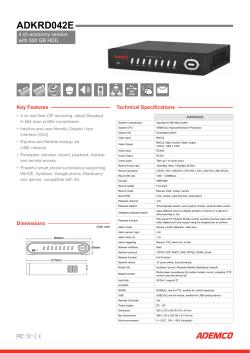
S4-CARLISLE Group E manual Fire alarm system
CHANGE Type: Modification 907.2.3 Change summary: The threshold for requiring a manual fire alarm system has been raised from 30 occupants to 50. The emergency voice/alarm communication system requirement has been raised to 100 occupants. Group E Manual Fire Alarm System 2015 Code: 907.2.3 Group E. A manual fire alarm system that initiates the occupant notification signal utilizing an emergency voice/alarm communication system meeting the requirements of Section 907.5.2.2 and installed in accordance with Section 907.6 shall be installed in Group E occupancies. When automatic sprinkler systems or smoke detectors are installed, such systems or detectors shall be connected to the building fire alarm system. Exceptions: 1. A manual fire alarm system is not required in Group E occupancies with an occupant load of 30 50 or less. International Code Council ® 2. Emergency voice/alarm communication systems meeting the requirements of Section 907.5.2.2 and installed in accordance with Section 907.6 shall not be required in Group E occupancies with occupant loads of 100 or less, provided that activation of the manual fire alarm system initiates an approved occupant notification signal in accordance with Section 907.5. 3. Manual fire alarm boxes are not required in Group E occupancies where all of the following apply: 3.1. Interior corridors are protected by smoke detectors. 3.2. Auditoriums, cafeterias, gymnasiums, and similar areas are protected by heat detectors or other approved detection devices. Manual fire alarm—double-action pull station 3.3. Shops and laboratories involving dusts or vapors are protected by heat detectors or other approved detection devices. 4. Manual fire alarm boxes shall not be required in Group E occupancies where all of the following apply: 4.1. The building is equipped throughout with an approved automatic sprinkler system installed in accordance with Section 903.3.1.1. 4.2. The emergency voice/alarm communication system will activate on sprinkler water flow. 4.3. Manual activation is provided from a normally occupied location. Change Significance: Many small schools or day-care facilities consist of one or two rooms. For such small buildings, there is no need to install a notification system to warn occupants of fires or other emergencies, as occupants are typically in close visual or audible contact with all occupied spaces and with each other. This arrangement provides for adequate means to notify all occupants of the building of potential hazardous 907.2.3 continues DESIGN SERVICES OF 907.2.3 continued conditions to initiate emergency actions, including evacuation. The use of an occupant load of 50 to trigger the requirement for a manual fire alarm system is now correlated to the same quantity of occupants used to require a second exit in group E occupancies. Exception 2 has been added to set the threshold for emergency voice/ alarm communication systems at a higher threshold than the 50 occupants or less that is used to require a manual fire alarm system. The threshold of 100 or less occupants has been selected to take into account educational occupancies containing multiple floor, fire areas, and egress paths. The occupants of these larger, more complex buildings may need to be provided with detailed or custom instructions on alternative courses of action other than those practiced in the standard evacuation drills. In summary, the changes made to Section 907.2.3 result in the following for Group E occupancies: When the occupant load is 50 or less, a manual fire alarm system is not required. When the occupant load is 51 to 100, a manual fire alarm system is required. When the occupant load is 101 or more, a manual fire alarm system with emergency voice/alarm communication system is required. DESIGN SERVICES OF
© Copyright 2025









